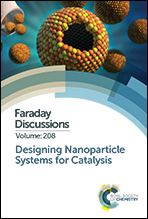Effects of heat treatment atmosphere on the structure and activity of Pt3Sn nanoparticle electrocatalysts: a characterisation case study†
Abstract
Comprehensive identification of the phases and atomic configurations of bimetallic nanoparticle catalysts are critical in understanding structure–property relationships in catalysis. However, control of the structure, whilst retaining the same composition, is challenging. Here, the same carbon supported Pt3Sn catalyst is annealed under air, Ar and H2 resulting in variation of the extent of alloying of the two components. The atmosphere-induced extent of alloying is characterised using a variety of methods including TEM, XRD, XPS, XANES and EXAFS and is defined as the fraction of Sn present as Sn0 (XPS and XANES) or the ratio of the calculated composition of the bimetallic particle to the nominal composition according to the stoichiometric ratio of the preparation (TEM, XRD and EXAFS). The values obtained depend on the structural method used, but the trend air < Ar < H2 annealed samples is consistent. These results are then used to provide insights regarding the electrocatalytic activity of Pt3Sn catalysts for CO, methanol, ethanol and 1-butanol oxidation and the roles of alloyed Sn and SnO2.

- This article is part of the themed collection: Designing Nanoparticle Systems for Catalysis


 Please wait while we load your content...
Please wait while we load your content...